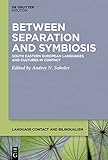Between Separation and Symbiosis : South Eastern European Languages and Cultures in Contact / ed. by Andrey N. Sobolev.
Material type: TextSeries: Language Contact and Bilingualism [LCB] ; 20Publisher: Berlin ; Boston : De Gruyter Mouton, [2021]Copyright date: ©2021Description: 1 online resource (XII, 328 p.)Content type:
TextSeries: Language Contact and Bilingualism [LCB] ; 20Publisher: Berlin ; Boston : De Gruyter Mouton, [2021]Copyright date: ©2021Description: 1 online resource (XII, 328 p.)Content type: - 9781501516641
- 9781501509216
- 9781501509254
- 404.2
- online - DeGruyter
- Issued also in print.
| Item type | Current library | Call number | URL | Status | Notes | Barcode | |
|---|---|---|---|---|---|---|---|
 eBook
eBook
|
Biblioteca "Angelicum" Pont. Univ. S.Tommaso d'Aquino Nuvola online | online - DeGruyter (Browse shelf(Opens below)) | Online access | Not for loan (Accesso limitato) | Accesso per gli utenti autorizzati / Access for authorized users | (dgr)9781501509254 |
Frontmatter -- Editor’s Preface -- Contents -- Contemporary Language Contacts in the Balkans: Situations and Outcomes -- Separation and Symbiosis between Slavs and Albanians as Continuum of Linguistic Contact Situations: New Challenges for New Data -- Mutual Understanding among Albanians, Slavs and Aromanians in Prespa, North Macedonia: Perfect Tense as a Perfect Tool -- “Balanced Language Contact” in Social Context: Velja Gorana in Southern Montenegro -- Symbiosis Suspectus: Palasa in Himara, Albania -- Minority within a Minority: Iabalcea and Carașova in Romania -- Evidence for Past Coexistence: Romance Stratum in Croatian Glagolitic Sources from Krk, Croatia -- Reconstructing Past Coexistence: Problems and Mysteries in the Multilingual History of Tsakonia, Greece -- Convergence and Failure to Converge in Relative Social Isolation: Balkan Judezmo -- Balkan Sprachbund Theory as a Research Paradigm -- Abbreviations -- Index of names -- Index of places -- Authors’ profiles
restricted access online access with authorization star
http://purl.org/coar/access_right/c_16ec
The book deals in detail with previously understudied language contact settings in the Balkans (South East Europe) that present a continuum between ethnic and linguistic separation and symbiosis among groups of people. The studies in this volume achieve several aims: they critically assess the Balkan Sprachbund theory; they analyse general contact theories against the background of new, original, representative field and historical Greek, Albanian, Romance, Slavic and Judesmo data; they employ and contribute to recent methods of research on linguistic convergence in bilingual societies; they propose new general assessments of extra- and intralinguistic factors of Balkanization over the centuries; and they outline prospects for future research. The factors relevant to contact scenarios and linguistic change in the Balkans are identified and typologized through models such as those related to a balanced or unbalanced (socio)linguistic situation.
Issued also in print.
Mode of access: Internet via World Wide Web.
In English.
Description based on online resource; title from PDF title page (publisher's Web site, viewed 25. Jun 2024)


